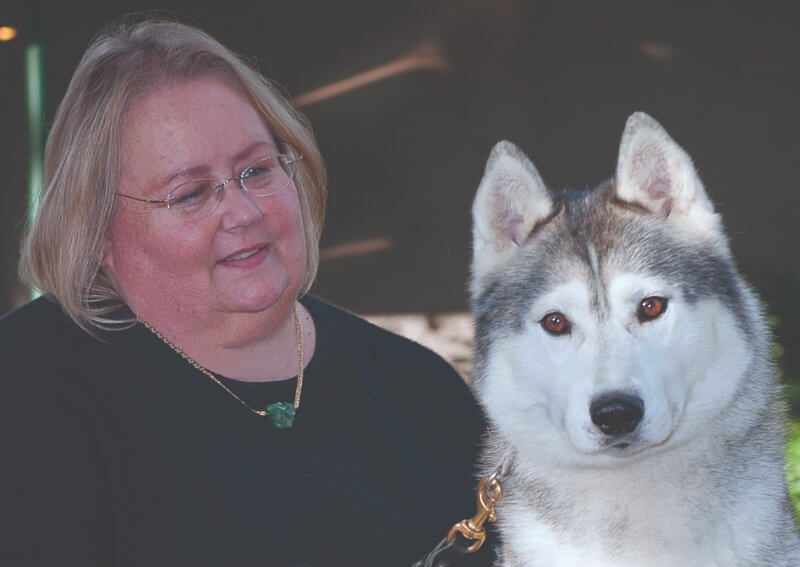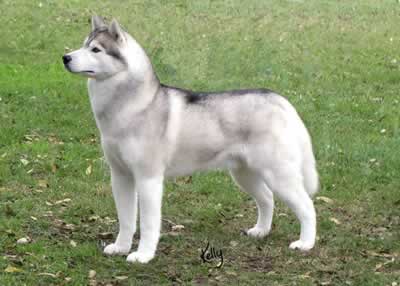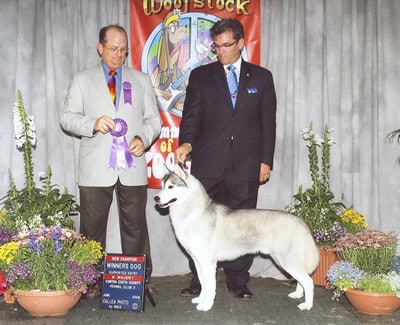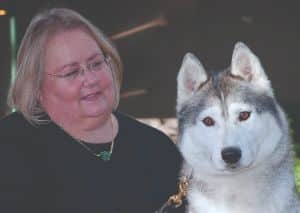
Home » Donna Beckman | Mistral Siberian Huskies

Interview with Donna Beckman, Breeder of Mistral Siberian Huskies
Donna Beckman: I live in the San Francisco Bay area in California. I have been in dogs since 1976, and I bred my first litter of Siberian Huskies in 1983.
Donna Beckman: My kennel name is Mistral Siberian Huskies, although, as I co-breed with Judy Russell, all of the co-bred dogs carry her kennel name of Karnovanda, Reg. I currently co-own fewer than 10 dogs, most of which reside with their co-owners.

Donna Beckman: My first show/breeding Siberians were bred on CH Dichoda’s Red. We had some racing dogs from Earl and Natalie Norris’s Alaskan-Anadyr lines that all came down from Towman’s Yakutat. The most recent Karnovanda dogs come down from our co-bred/co-owned GCH CH Karnovanda’s Your Teddy Bear, “Ted,” and Karnovanda’s Simon.

Donna Beckman: We have never kept that many dogs on our property, and they have all been housedogs. All litters have been whelped and raised in the house (bedroom, den, kitchen, and even living room). All dogs—even show dogs—are pets, and we try to raise them to be good pets.
Donna Beckman: Deciding which show/breeding puppies to keep is less a selection process than a process of attrition. As puppies grow, their strengths and weaknesses appear. Depending on the purpose of the breeding, those weaknesses can eliminate puppies from further consideration. When final decisions need to be made, one must determine if those remaining puppies (although not eliminated from consideration) are actually worth keeping. Do they bring you closer to your goal? Do they provide you with what you wanted to achieve by the breeding? Decisions should be made with one’s head, not one’s heart. And, the later the decision, the better, even after the puppy is an adult.
Donna Beckman: Psychological preparation includes good socialization such as exposure to buildings, lawn, tents, people, dogs, noises, etc. Show preparation includes becoming familiar with a show lead, standing, gaiting, standing for examination, etc. We are lucky that the Siberian is to be presented in a natural state, so a bath, brushing/combing, nail trim, and perhaps a trim of the long fur on the feet are the few steps to grooming. Trimming of the coat is strictly prohibited.
Donna Beckman: I have concerns about the two major presentation trends I see in the show ring. The first is over-grooming, particularly trimming/scissoring/clippering/thinning of the coat. Whether done out of ignorance or in an attempt to cover up a structural or coat fault, altering a correct Siberian Husky is dangerous to his survival. I encourage exhibitors to curtail this practice.
The second trend is to move Siberian Huskies too quickly. The Standard states, “…in the show ring should be gaited on a loose lead at a moderately fast trot…” Exhibitors should comply and judges should insist. I suspect handlers do this to draw attention to an exhibit’s extraordinary sidegait. This is ridiculous, as the Siberian is to have a very efficient sidegait without exaggeration. By moving a Siberian Husky too fast, a handler usually causes the Siberian to show a myriad of movement faults, including crossing-over, interfering, moving wide, and sidewinding. Please move more slowly.
Donna Beckman: We are very lucky that the Siberian Husky is usually quite healthy. The breed has some eye disorders and we hear of some other canine maladies, but these are not usually as prevalent as in other breeds. Recently, the SHCA Trust, a non-profit organization charged with fundraising and funding efforts in the areas of Health, Education, and Rescue, has funded a research team at the University of Wisconsin to map the Siberian Husky Genome end-to-end. When complete, health and genetic researchers may use this map to study other health issues, with the goal to eradicate them.
For years, the more experienced, longtime breeders felt that Siberian Huskies were healthier by eating a higher protein and fat diet. Recently, research has provided scientific support for this theory. In running tests on wolves and domesticated dogs, they discovered that while most domestic dogs’ genes contain hundreds of occurrences of the enzyme amylase (which helps to digest starches into usable fuel), the Siberian Husky only has a few instances of amylase in its genes. The assumption is that Siberians did not come from an agrarian society with much exposure to starches and did not develop the ability to digest and use starches. So, I encourage owners to consider this when feeding Siberians.
Donna Beckman: There are a couple of trends I see in the Siberian Husky (and, unfortunately, in most breeds I judge) that are greatly concerning: angles and bone lengths. I am referring specifically to shoulder layback and return of upper arm, and the unequal lengths of the scapula and humerus. And, in the hindquarters, the slope to the croup, angulation in the rear, and the unequal lengths of the first and second thighs. These are severe structural problems in any breed, but will not allow a Siberian to do his job of “…carrying a light load at a moderate speed over great distances.” Unfortunately, it is sometimes difficult to find a dog of correct structure.
Donna Beckman: Siberian Huskies make wonderful family dogs for those who are willing to understand them and who have a great sense of humor. Their job is to run, so they need to be leashed or kept in a secure enclosure. They love to chase small animals, and often catch them. They are very smart, usually learn quickly, and may not think they need to show you that they know they are not to destroy your new shoes.
Siberian Huskies are independent. (The lead dog who disobeys the musher’s command to turn because he knows that a left turn is dangerous, and your pet who doesn’t come when called, share that same independent spirit.) They learn things that are fun to them, or that allow them to use their innate skills, but may not be all that interested in retrieving a tennis ball. A good Siberian owner will not only allow them to show that sometimes frustrating personality, but will revel in it. And, the best Siberian owners will soon realize that Siberian Huskies are open to negotiation and bribery, especially when treats are involved.
Donna Beckman: This is of concern to me. We were lucky to have met some of the icons of our breed; those who sought AKC recognition, those who first fell in love with these Siberian dogs, and those who initially popularized the breed. It was from these breeders and others who came soon after them that we were fortunate to learn about dogs, sledding, animal husbandry, and the dog show ring, and it was to them we turned for answers. We were very lucky. The day of the “big” breeders and all of their knowledge is slipping away, and I fear that many current and future breeders (and our breed) will suffer that loss. To new breeders, I encourage them to meet those current icons, listen to them, and gather all the history and knowledge they have.
Donna Beckman: Owning, exhibiting, breeding, and judging Siberian Huskies have made me laugh for over 40 years.
The best way to ensure a long and happy relationship with a purebred dog is to purchase one from a responsible breeder. Not sure where to begin finding a breeder? Contact the National Parent Club’s Breeder Referral person, which you can find on the AKC Breeder Referral Contacts page.
Did you know nearly every recognized AKC purebred has a dedicated rescue group? Find your new best friend on the AKC Rescue Network Listing.
Showsight Magazine is the only publication to offer dedicated Digital Breed Magazines for ALL recognized AKC Breeds.
Read and learn more about the loyal Siberian Husky dog breed with articles and information in our Siberian Husky Dog Breed Magazine.
Error embedding FlippingBook shortcode, please check the flipbook url. (https://digital.showsightmagazine.com/view/178951/)
